Lake Titicaca borders Bolivia and Peru so that was our entry point into Peru on our Overland truck. Puno was our base for an overnight trip out on the world's largest navigable lake. Our boat first stopped at the Uros Islands, which are floating islands made of reeds. We then cruised on a couple of hours to Armantani where we stayed as groups of 4 with local families. Our family was very welcoming and gave us some much needed Spanish practice. The house was surprisingly large - 2 stories with a courtyard in the middle - and the food was delicious - lots of soup, rice and potatoes. Our group enjoyed a soccer game against the locals, a hike to ruins at the top of the Island and a 'discotek' where we dressed up in traditional clothing and danced the night away to a local band with pipe-type instruments. The next day we boated to Taquille Island for a walk around, to see the knitting men and to enjoy a freshly caught trout lunch.
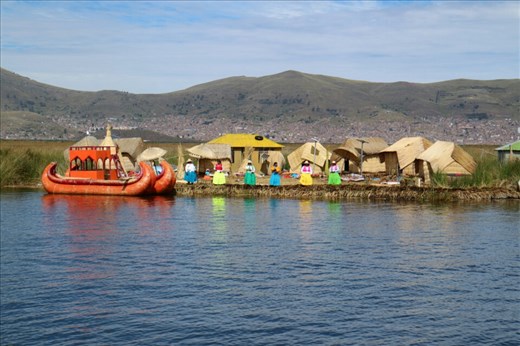
After Lake Titicaca we drove to Cusco, the old capital of the Incan Empire and a real trip highlight. A lot of the old Incan foundations are still there with Spanish colonial buildings on top. We spent three days wondering around through the cobbled streets, visiting churches and museums, souvenir shopping and just generally enjoying staying in one place for a bit, eating, drinking and catching up with friends who had left the tour earlier. One morning Josh got up at three am to head out to Rainbow Mountains. It was a tough 4 hour hike at high altitude but he was rewarded with great views.
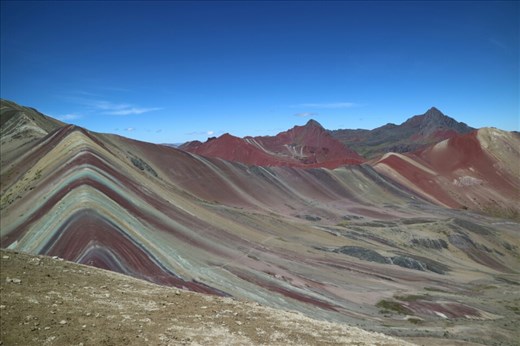
We then left the comforts of Cusco for our 4 day, 42 km Inca Trek. The hike was challenging and reached heighrs of 4200 m and involved a hell of a lot of stairs. We couldn't really complain though when porters were carrying all our stuff, even tables and chairs to eat at and enough food for 3 course meals! Of course the trek culminated with Machu Picchu on the final morning. When we reached the Sungate after a 3:30 am start, we were met with incredible views of... fog. Total, complete, whiteout fog. After a rather subdued tour around the surprisingly large 'lost city', we hung around for hours hoping the weather would clear. Thankfully it did and we were eventually rewarded with amazing views over the whole city.
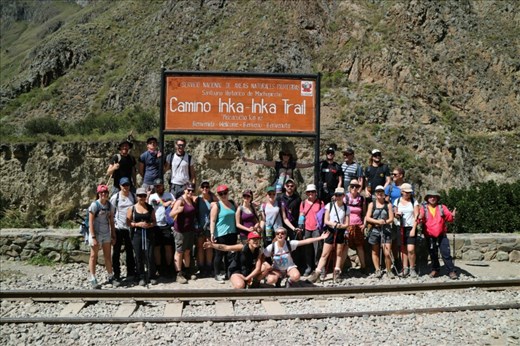

Upon returning to Cusco we had a bit of a relaxing day, doing trip planning and getting a massage to soothe tired muscles. We did make it to the San Pedro markets where apparently they do a good, freshly blended frog juice. There were plenty of roast guinea pigs around as well as whole pig and cow heads.
Arequipa was next on the itinerary. A town of about 1 million people, with a lovely colonial town square complete with mandatory Cathedral, it was a nice place for some down time. We went go carting there ($2 for three laps!) which was a laugh and the Monasterio De Santa Catalina, which covers a whole block, was well worth a visit. It was a very peaceful place and it was lovely to walk through the narrow streets, peep into the cells and imagine how the nuns would have lived hundreds of years ago.
Puerto Inca was our next campsite. Set in a pretty but arid cove with tall headlands on either side, the Incas used to walk here to get fresh fish for their king in Cusco. We enjoyed being back by the coast for the afternoon with all that entails: swimming in the freezing water, lazing in the sun, volleyball and beers in the beach bar.
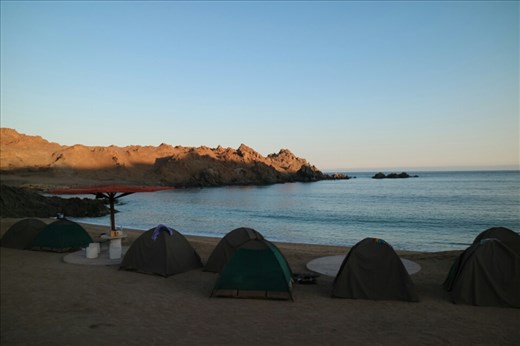
We drove through more desert bordering the coast, stopping by Chauchilla cemetery where we saw yet more mummies, and an archaeological site where they are currently unearthing a city of pyramid like structures that will be bigger than Machu Picchu when they finish.
In the afternoon, we reached Nazca, with the huge, mysterious lines etched into the desert floor. Karen did a scenic flight over the lines in a small 8 seater plane. We got really good views of the animals and geometric shapes and lines. They looked quite small from the air but in actual fact, reach up to lengths of about 300 m. Much of the flight was spent sideways and circling so at the end of the half hour, I was sweating bullets and was quite relieved to get out of those G forces with my lunch still in my stomach! There wasn't too much to do in Nazca itself but the people were really friendly and our campground had a pool, and it was finally warm enough for us to actually enjoy it! Chris and I did pop into the Observatory at the Nazca Lines hotel, where they explained some theories about the lines, ie that they were made to win favor with the gods, or to point to water sources or to match the constellations. They were discovered in the 1920s but could have been there for hundreds of years and were made by removing the darker colored top rocks to leave the lighter rocks underneath exposed. At the Observatory we also got to peek through the massive telescope and check out the moons of Jupiter. The next day we stopped by a viewing platform where you could see oblique views of some of the figures and really appreciate their size.


Huacachina desert oasis was a fun stop. Josh went on an overnight excursion which involved dune buggying, sand boarding, jungle juice and sleeping under the stars while I hung out in town and enjoyed a few cocktails by the oasis with Lin. Since there was live music playing all night in town, making it hard to sleep, I got up before dawn for a hard, sweaty climb up a giant sand dune to watch the sun rise.
On the way to Lima, we stopped at the Ballestas Islands, AKA the poor man's Gallapagas. Being poor men (or women) we enjoyed the chance to do a boat cruise where we saw a surprising number of seals, penguins, pelicans and other birds. The craggy islands themselves with their rocky arches were starkly beautiful. It felt a little bit like Kangaroo Island.
Lima is a big, sprawling city with about 10 million people. It is busy and noisy, but like most South American cities, has lovely plazas with European style buildings, complete with arches, fountains, statues, churches and palaces. Shopping seemed to be the thing to do there, but with limited money and bag space, we headed instead to San Francisco monastery, where the catacombs with 75 000 sets of bones is the major drawcard. It was interesting but a bit creepy, and when people were throwing coins into the graves for wishes, it just got weird. I guess I should be getting used to bodies after all the mummies we've seen but there's still something vaguely unsettling about open graves. On a brighter note, we had awesome crepes at a French Cafe overlooking the beach in the suburb of Miraflores and we enjoyed some luxury, staying in a nice hotel instead of hostels or camping (Tucan always seems to splash out on the joining hotels - lulling travelers into a false sense of security, perhaps? But we actually have grown to love the camping anyway - relaxing in nice settings, hanging out with the group, awesome home cooked food, cheap drinks).
After Lima we drove a day to Huaraz. It's good that it is set in a stunning valley with nice hiking and activities around because the town itself isn't much. Not their fault though, seeing as it was flattened by an earthquake in the 70's and had to be rebuilt. The first day we got a 3 hour bus to a national park. There we hiked to Laguna 69 (named only because it was the 69th Lake discovered in the region). The scenery was stunning - unbelievably blue lakes, waterfalls, glaciers, wildflowers, gurgling streams, the highest mountain in Peru as a backdrop - which made the 3 hour ascent at altitudes of up to 4700m worth it. At the top we were awarded with a fantastic view of a bright blue glacial lake, with snow-capped mountains behind it. There was one injury - our friend Chris slipped and gashed his leg on a rock, which later required stitches. That night we celebrated our hiking victory playing Cards Against Humanity and drinking too much vino, which made the following day's uphill 14km hike at Willkawain very tough (I only made it halfway before deciding to chill out in a campground and Josh didn't even attempt it).
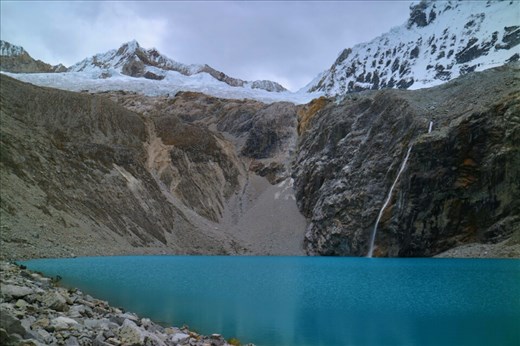
Our next stop was Huanchaco, a small break town from where we visited the Moche temple ruins of Huaca la Luna, with its well preserved painted walls, and Chan Chan, Chimu ruins that were once one of the largest adobe cities in the world. Josh also tried his hand at surfing here, but didn't have much luck and I was amused by the dozens of little crabs that were scuttling around on the sand.
El Museo Tumbas Reales de Sipan was a good place to break our next long drive day. It was a very modern museum with the contents of royal tombs from the Moche people, including ceremics, gold ornaments and jewelery and human remains.
Our final stop was Mancora, a beach resort town in the desert. We stayed at Loki hostel, where the party raged each night and hammocks and deck chairs by the pool assisted our recovery during the days. The beach here was nice and sandy and the water was a nice temperature for swimming. The beach bars had yummy, cheap meals (I had avocado stuffed with shrimp for $5) and drinking on the beach was legal, so we could enjoy some sundowners. The only activity I roused my lazy ass for here was swimming with the giant sea turtles at nearby El Nuro, a half an hour mototaxi (tuk tuk) drive away. From the pier, you could climb down a ladder and snorkel with the turtles that swam close enough to touch. Magical!
So Peru was all it was cracked up to be - history, an incredible variety of landscapes, interesting foods (ceviche, or marinated raw seafood is a personal favorite), good prices and fun outdoor activities.